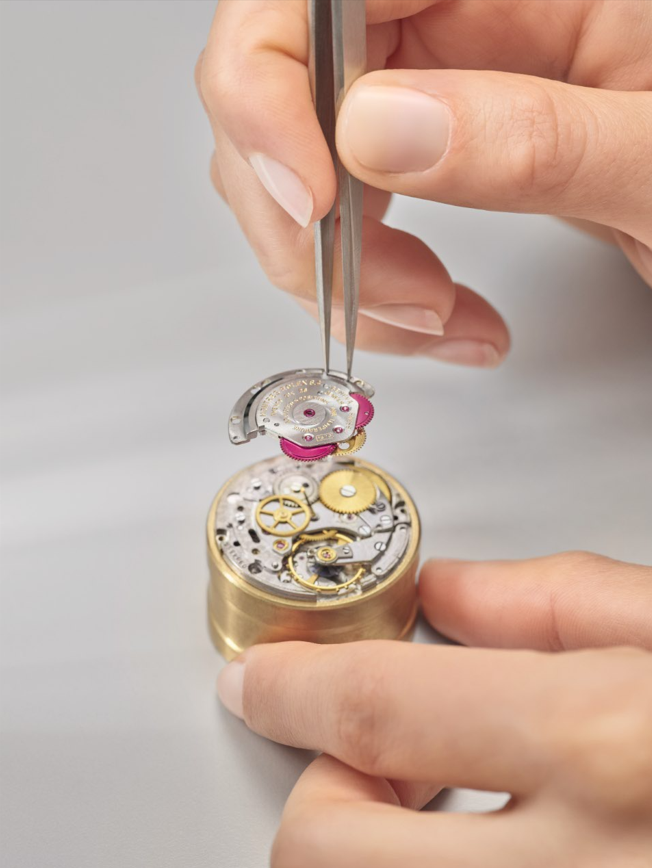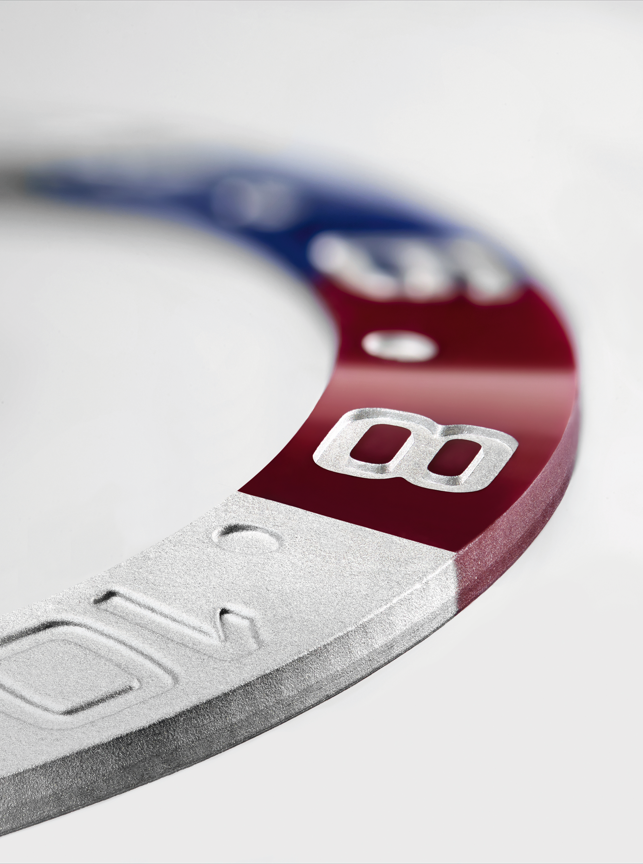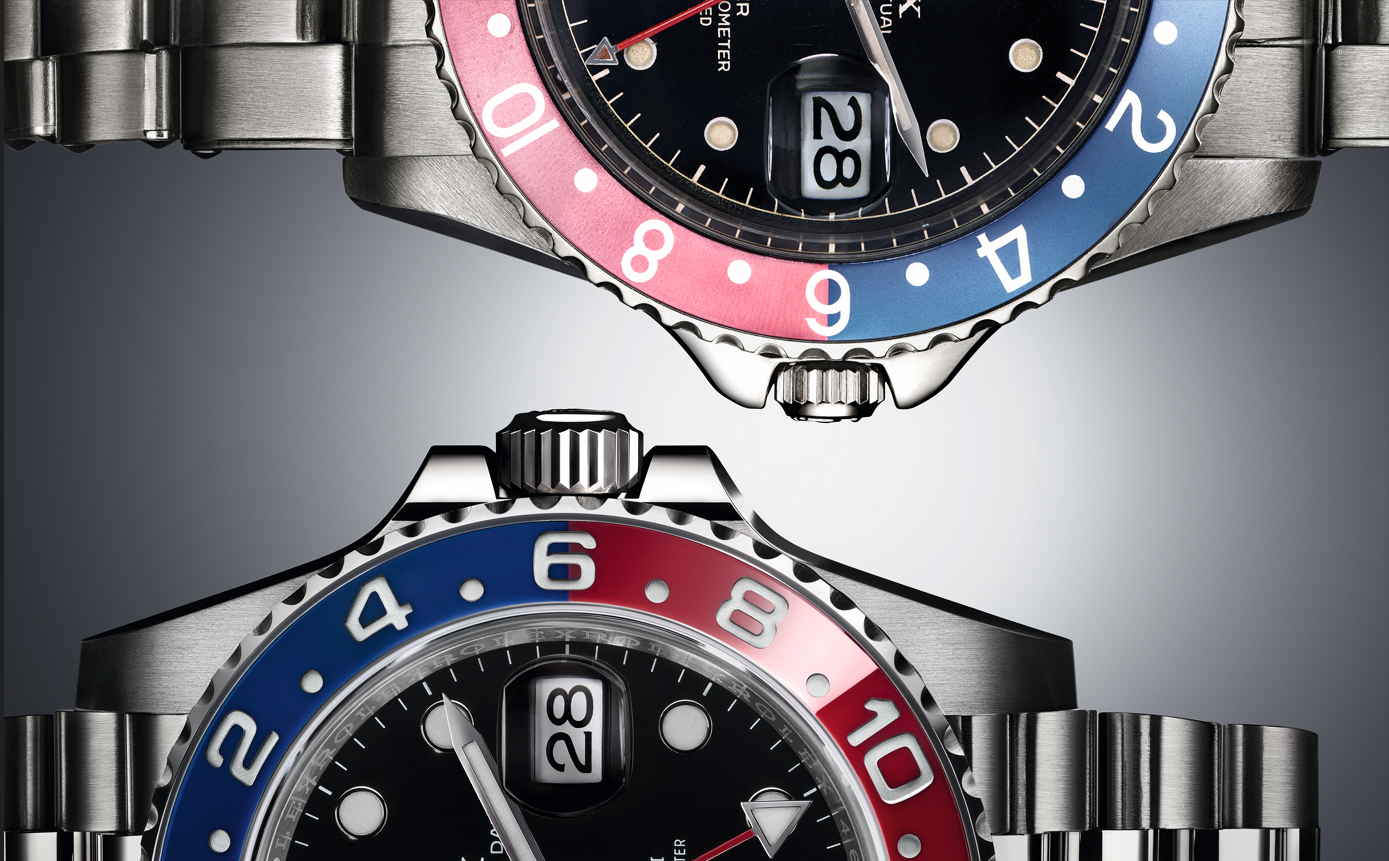When Rolex introduced the GMT-Master in 1955, a watch specifically designed to meet the needs of aviators, it swiftly became the gold standard for travelfriendly timepieces. Its innovative 24-hour graduated, rotatable two-colour bezel and dedicated 24-hour hand allowed wearers to read two time zones at a glance. The thoughtful design was further enhanced by the now-iconic red and blue bi-colour bezel, which helped distinguish between day and night hours in the second time zone.
The original Rolex Oyster Perpetual GMT-Master was born to meet the needs of a more interconnected world. That legacy gave rise to the modern Oyster Perpetual GMT-Master II, a watch that combines iconic design, functionality, and cutting-edge materials.
 24-HOUR HANDS OF DIFFERENT VERSIONS OF THE GMT-MASTER II
24-HOUR HANDS OF DIFFERENT VERSIONS OF THE GMT-MASTER II
Paired with Rolex’s dedication to durability and precise timekeeping, the GMT-Master was officially adopted by Pan American World Airways, better known as Pan Am, the most prominent American intercontinental airline at the time, just four years after its launch. In the same year, the 24-hour graduated bezel insert was upgraded from Plexiglas to anodised aluminium to make its surface more durable, and a winding crown guard was added as an integral part of the middle case. Unsurprisingly, the GMT-Master’s popularity soared, becoming a favourite among a new cosmopolitan generation, and was often seen on the wrists of globetrotters, explorers, and adventurers.
The GMT-Master continued to evolve and adapt to the needs of a perpetually changing world. In 1982, the GMT-Master received a new movement featuring an independently adjustable hour hand, allowing the wearer to set the local time without affecting the 24-hour or minute hands. This significant improvement warranted a new name, and the GMT-Master II was born, featuring a distinctive burgundy and black bezel insert, a combination exclusive to the new model.
 ASSEMBLY OF THE AUTOMATIC WINDING SYSTEM ON CALIBRE 1575, WITH WHICH THE GMT-MASTER WAS EQUIPPED FROM 1965 TO 1983
ASSEMBLY OF THE AUTOMATIC WINDING SYSTEM ON CALIBRE 1575, WITH WHICH THE GMT-MASTER WAS EQUIPPED FROM 1965 TO 1983
In the years that followed, the GMT-Master II underwent subtle changes that enhanced its appearance, wearability, and performance. New bezel colours, metal configurations, and bracelet options were introduced, and Super-LumiNova eventually replaced tritium for luminescence.
However, one of the most significant updates came in 2005 with the transition from aluminium to ceramic bezel inserts. This high-tech ceramic was designed to be virtually scratchproof, and more durable than its predecessor, promising rich and vibrant colours that won’t fade over time due to its resistance to ultraviolet rays, saltwater, and other environmental factors. Dubbed “Cerachrom” in 2008, the first two-colour monobloc Cerachrom insert was unveiled — in blue and black in 2013 — a truly impressive feat of engineering and applied research.
(Related: Transformative Mentorships Perpetuating Artistic Heritage)
 RED AND BLUE CERACHROM BEZEL INSERT DURING SURFACE POLISHING, FOLLOWING COATING OF THE INSCRIPTIONS
RED AND BLUE CERACHROM BEZEL INSERT DURING SURFACE POLISHING, FOLLOWING COATING OF THE INSCRIPTIONS
With all the variations that continued to be released, the GMT-Master II garnered a following not only among professional users but also among watch enthusiasts. In line with its commitment to addressing specific wearer needs, Rolex introduced a left-handed version of the GMT-Master II in 2022. This model featured the winding crown and date window relocated to the left side of the case, making it the only Rolex watch in today’s offering with such a configuration, enhancing its appeal.
Two new variants have joined the collection this year, featuring a more understated aesthetic with Cerachrom bezel inserts in black and grey to complement the black dial. The black lacquer dial bears the inscription ‘GMT-Master II’ in green, echoing the colour of the triangle-tipped 24-hour hand — an element that features strongly in the model’s design.
 GMT-MASTER, STAINLESS STEEL, RED AND BLUE BEZEL INSERT, 1959 (ABOVE) AND GMT-MASTER II, OYSTERSTEEL, RED AND BLUE BEZEL INSERT, 2018 (BELOW)
GMT-MASTER, STAINLESS STEEL, RED AND BLUE BEZEL INSERT, 1959 (ABOVE) AND GMT-MASTER II, OYSTERSTEEL, RED AND BLUE BEZEL INSERT, 2018 (BELOW)
The difference between the two models lies in their bracelets: One is equipped with an Oyster bracelet, while the other comes with a Jubilee bracelet. With these additions, the GMT-Master II family now offers a total of 14 different configurations, catering to a diverse clientele united by a passion for travel and timeless design.











 Back
Back
